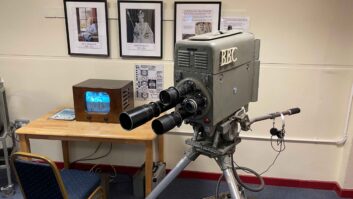A year-long trial with a Harris Atlas Digital DTV660L DVB-T transmitter proves the technical and commercial viability for DVB-H in Australia.
The July 2005 launch of the world’s first high-power trial of digital video broadcast to handheld (DVB-H) technology marked an important milestone for digital television. Conducted over the past year by Broadcast Australia, Australia’s leading independent broadcast transmission provider, using an Atlas Digital DTV660L liquid-cooled DVB-T transmitter from Harris Corporation, the DVB-H trial aimed to test the technical capability and commercial prospects for DVB-H applications in Australia and globally.
For this trial, Broadcast Australia worked with Harris, telecommunications provider Telstra, and wireless antenna and cable manufacturer Radio Frequency Systems (RFS). Comprising the delivery of 16 channels of live-streamed, diverse content to 400 trial users, the trial explored the technical aspects and usage patterns of multichannel mobile media services.
“By selecting the Harris Atlas Digital DTV660L transmitters, Broadcast Australia has been able to achieve its objectives for two high-profile digital broadcasting trials,” said Clive Morton, Broadcast Australia broadcast services director. “In addition, the transmitters have reduced operating costs through efficient energy consumption, along with compact and quiet operation, while permitting easy monitoring and control of the system from anywhere at anytime.”
Broadcast Australia selected The Bridge Networks to supply a Harris Atlas Digital DTV660L liquid-cooled DVB-T transmitter (operating in DVB-H mode) for the task. The transmitter provides 3.4kW of power from a single cabinet into an existing, multi-coupled UHF antenna system, delivering 80kW effective radiated power (ERP), covering the major part of the Sydney metropolitan area. Key benefits of the Harris transmitter are its compact design and quiet operation. Being liquid-cooled, it presents a single-cabinet footprint, while the cooling system, pump module and heat exchanger are located conveniently away from the main cabinet. This made it an ideal fit into Broadcast Australia’s newly built transmitter hall at the Gore Hill broadcast site. Based on these attributes, Broadcast Australia also decided to upgrade the transmission system of its digital datacasting trial. This involved installing an identical Harris 3.4kW liquid-cooled transmitter (operating in DVB-T mode) in the same transmitter hall. Since both systems now use the same model transmitter, Broadcast Australia can employ common spare components across both the DVB-H and datacasting trials, and enjoy streamlined operations and maintenance procedures.
The front-access, modular design and redundant amplifier system provide the ability to service the power amplifier modules on-air without service interruption. The transmitter front-end user interface is common for low- and high-power operation. The transmitter has been readily integrated into Broadcast Australia’s existing 24×7 Network Operations Centre (NOC) for monitoring and forward control purposes. The SNMP, GUI and Web browser interface make it easy for the NOC team to interrogate the transmission system from the NOC or any other location.







